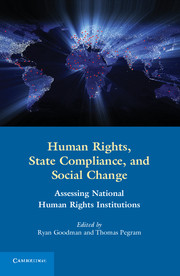Book contents
- Frontmatter
- Contents
- Contributors
- Preface
- 1 Introduction
- PART I NHRIs in Theory and Reality
- 2 National Human Rights Institutions and State Compliance
- 3 The Shifting Boundaries of NHRI Definition in the International System
- 4 Evaluating NHRIs
- PART II NHRI Performance
- PART III NHRIs and Compliance
- PART IV Final Reflections
- Annex 1
- Index
- References
3 - The Shifting Boundaries of NHRI Definition in the International System
from PART I - NHRIs in Theory and Reality
Published online by Cambridge University Press: 05 June 2012
- Frontmatter
- Contents
- Contributors
- Preface
- 1 Introduction
- PART I NHRIs in Theory and Reality
- 2 National Human Rights Institutions and State Compliance
- 3 The Shifting Boundaries of NHRI Definition in the International System
- 4 Evaluating NHRIs
- PART II NHRI Performance
- PART III NHRIs and Compliance
- PART IV Final Reflections
- Annex 1
- Index
- References
Summary
Introduction
NHRIs and related institutions for the protection and promotion of human rights are horizontal accountability state institutions that provide checks and balances on government conduct. Most of them do not have the power to impose their own decisions on the government. Instead, they are given a range of soft powers, from advice and recommendation to the ability to bring actions before constitutional and other courts.
A sustained focus has been placed on NHRIs for two decades, yet there are still different points of view on which domestic institutions involved in human rights protection and promotion should be identified as NHRIs. NHRI identification is increasingly important on the international level for the access it brings to the human rights machinery of the UN and other regional organizations. However, NHRI identification has been complicated over the same period by the establishment of a variety of domestic institutions that engage fully or partly in human rights activities.
- Type
- Chapter
- Information
- Human Rights, State Compliance, and Social ChangeAssessing National Human Rights Institutions, pp. 52 - 73Publisher: Cambridge University PressPrint publication year: 2011
References
- 1
- Cited by



